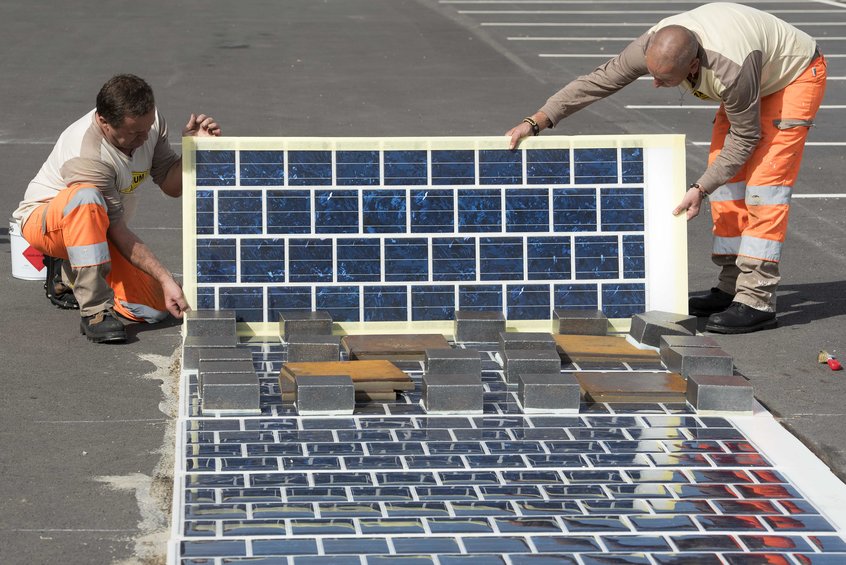In France, opened the first road, covered with solar panels

Recently, the authorities of the city Turuvr in France solemnly opened a test section of the road, covered with solar panels. According to the authors of the project, the energy that these panels will generate is enough to cover all the streets of Turóvra. True, the town itself is small - its area is only 24.01 km ² , and the population of Turuvr is a little more than one and a half thousand people. The carriageway is covered with stripes with photocells of 7 mm thickness.
Solar panels covered the length of the road just a kilometer. The total area of the road section paved with photovoltaic cells is 2800 square meters. It is clear that the panels are protected from the effects of external factors (weather, physical impact of passing cars and passing people). The main protection is rubberized coating. Despite the small scale of the project, Marie-Ségolène Royal, Minister of Ecology, Sustainable Development and Energy of France, took part in the launch ceremony.
This shows the significance of the “solar road” in the eyes of the French government. "A new way of using solar energy opens up the possibility of operating an existing infrastructure for producing energy," said Royal. According to the minister, the current project is only a pilot phase of the project with a duration of four years. As part of this initiative, solar panels will cover canvas tracks in other regions of the country. But this is only if the current stage proves successful.
')
Every day on this road Turuvra passes about 2000 cars. Of course, protection for photovoltaic cells must be reliable in order to withstand such a load. The main idea is the generation of electricity at a time when cars are not driving on the highway. The canvas is not covered by the sun 80% of the time. All this time, the roads are not exploited and “idle”, so to speak. In some regions, the canvas is used even less.

France is not the only country where such a project is being tested. Similar programs are implemented in Germany, the Netherlands and the USA.
In France, the project is being implemented by Colas, a subsidiary of the construction giant Bouygues. According to company representatives, if 250 thousand kilometers of roads were covered with solar panels, then the generated energy would be enough for the whole country. A 250 thousand - this is only a quarter of the length of the roadway in the country. Of course, so far we can only dream of implementing such a large-scale plan, but in theory this is the case.
In the next five years, the French are going to pave with specially designed panels of a road with a total length of 1000 km. Thousands of kilometers of panels should be enough for the needs of 5 million people, or 8% of the current population of the country. It took Colas five years to develop the Wattway cells with which they cover the roads. These cells contain a thin film of polycrystalline silicon.
The project has opponents, or rather, experts who doubt that the “sunny” road will withstand all the vicissitudes of the weather, and will also be stable over time. But do not forget about more heavy trucks, which from time to time drive on the slopes. In the Netherlands, for example, a test section of the road, covered with similar panels, could not bear the load. About 70 meters of the “solar” canvas fell into disrepair. On the other hand, the problem was quickly resolved, and a web capable of generating energy was restored.
Another argument of the opponents of the project is that solar panels that are installed at an angle are much more efficient in terms of generating electricity than photovoltaic cells placed on a flat surface without any tilt.
And, of course, the main argument is the cost of a kilowatt peak of "solar" energy. The performance of solar photovoltaic systems is measured in kilowatt-peak. This term refers to the maximum power that a photovoltaic module can achieve under optimal conditions for absorbing solar radiation. These conditions include the best condition of the panel, its position and maximum thermal efficiency. So, in the case of paved roads with solar panels in France, the kilowatt peak is 17 euros. At the same time, for solar panels that are installed on the roofs, this figure is only 1.3 euros. Such a big difference so far is an obstacle for large-scale project implementation.
But if he shows himself well, the government can give the green light to further implement and expand its scope. According to the company Colas, competitive compared to solar panels on the roof of the "solar roads" can be closer to 2020. By the way, according to statistics, the cost of generating solar energy has decreased in France from 2009 to 2015 by 60%.

As mentioned above, France is not the only country where it is planned to generate electricity using the area of the roadway. Similar projects are being implemented, for example, in the USA , where one of the companies, Solar Roadways, was able to develop heavy-duty glass plates that can be used as a road covering, passing light to photoelectric elements. In the Netherlands, solar panels pave the way for a bicycle.
Source: https://habr.com/ru/post/400289/
All Articles